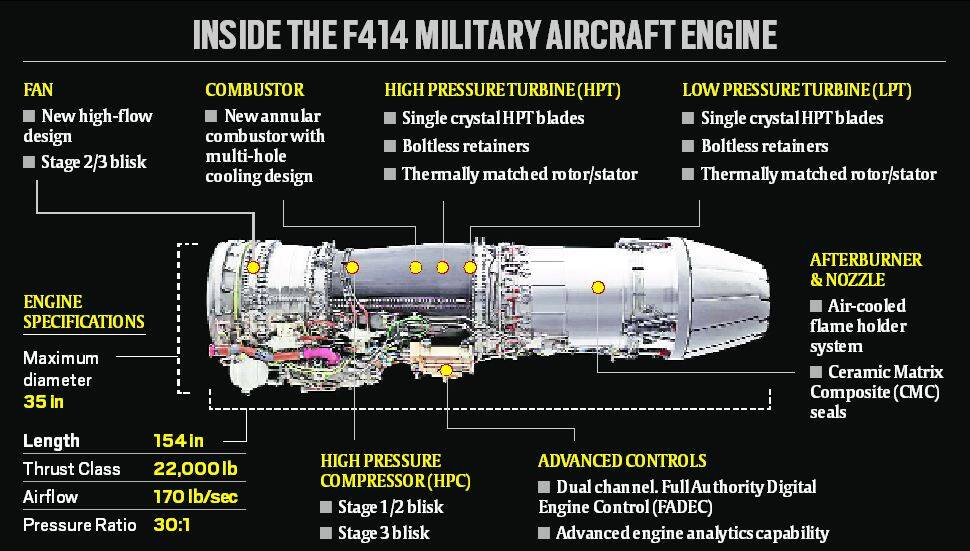International Relations
India's Jet Engine Deal with the US
- 23 Jun 2023
- 7 min read
For Prelims: LCA Tejas Mk2, F414 engine, Defence Research Development Organisation (DRDO), critical technologies
For Mains: Significance of India's efforts to achieve self-reliance in critical technologies, Potential benefits of cooperation in critical and emerging technology
Why in News?
Recently, India has announced a significant agreement between the American multinational corporation General Electric (GE) and Hindustan Aeronautics Limited (HAL), during Indian PM's state visit to the US. The deal involves the transfer of critical jet engine technologies and the manufacturing of GE's F414 engine for India's indigenous Light Combat Aircraft (LCA) Tejas Mk2.
- This development marks a crucial milestone in India's pursuit of advanced combat jet engine technology.
Note:
- The India-US Defence Acceleration Ecosystem (INDUS-X) was also launched during the ongoing visit of the PM.
- INDUS-X is meant as a platform for Indian and U.S. start-ups and tech companies to collaborate for the co-development and co-production of advanced technologies.
What is GE's F414 engine?
- About:
- GE's F414 engine is a turbofan engine used by the US Navy for over 30 years.
- It is equipped with a dual-channel full authority digital engine control (FADEC), a six-stage high-pressure compressor, an advanced high-pressure turbine, and a "fueldraulic" system for nozzle area control.
- It offers exceptional throttle response, excellent afterburner light and stability, and unrestricted engine performance when required.
- The F414 engine has powered military aircraft in eight nations, making it a trusted choice for modern fighter jets.
- GE's F414 engine is a turbofan engine used by the US Navy for over 30 years.
- India's Engine Requirements:
- For India, the F414 engine holds great significance, particularly in the context of the LCA Tejas Mk2.
- The Aeronautical Development Agency (ADA) of the DRDO has selected the India-specific version of the engine, known as F414-INS6, for the LCA Tejas Mk2.
- This strategic decision reflects India's aim to bolster its indigenous defence capabilities and reduce dependence on foreign suppliers.
- Furthermore, there are prospects of utilizing F414 engines for the Advanced Medium Combat Aircraft (AMCA), India's ambitious fifth-generation fighter aircraft.
- For India, the F414 engine holds great significance, particularly in the context of the LCA Tejas Mk2.
What is LCA Tejas Mk2?
- The LCA Tejas Mk2 is an upgraded version of the indigenous fighter aircraft developed in India.
- It has the capability to carry eight Beyond-Visual-Range (BVR) missiles simultaneously and integrate both native and advanced weapons from other countries.
- The LCA Mk2 offers improved range and mission endurance compared to its predecessor, with a mission endurance of 120 minutes, as opposed to 57 minutes for the LCA Tejas Mk1.
- It is intended to serve as a replacement for the Jaguars, MiG-29s, and Mirage 2000s as they retire in the coming decade. Manufacturing has already begun, and the aircraft is expected to be rolled out by 2024.
Why is the India-US Jet Engine Deal Significant?
- Self-reliance in Critical Technologies:
- Manufacturing engines for combat aircraft requires advanced technology and metallurgy, which only US, Russia, UK and France have mastered.
- India, despite its push for self-reliance in critical technologies, including cryogenic rocket engines, has not been able to join this list.
- The countries that have the technology to manufacture advanced engines for fighter aircraft have been traditionally unwilling to share them which is also why the deal is pathbreaking.
- Manufacturing engines for combat aircraft requires advanced technology and metallurgy, which only US, Russia, UK and France have mastered.
- A Significant Component of iCET:
- The agreement for the transfer of technology was discussed in the talks between India's Defence Minister and the US Secretary of Defence earlier in June 2023 and was a key highlight of India's National Security Advisor’s meeting with his US counterpart when the US-India iCET was operationalized.
- Development Efforts by DRDO:
- The DRDO's Gas Turbine Research Establishment (GTRE) initiated the development of the GTX-37 engine for the LCA, followed by the ambitious Kaveri engine project in 1989.
- Despite the development of 9 full prototype engines and 4 core engines and extensive testing, the engines did not meet the requirements for fighter aircraft making this deal crucial for its defence capabilities.
- The DRDO's Gas Turbine Research Establishment (GTRE) initiated the development of the GTX-37 engine for the LCA, followed by the ambitious Kaveri engine project in 1989.
- End of Technology Denial Regime:
- This pact finally lays to rest what former PM of India (in 2008) had described in as the “technology denial regime” imposed on India by the West, led by the US.
- The Nuclear Suppliers’ Group’s waiver to the Indo-US nuclear deal marked the end of India’s decades long isolation from the nuclear technology.
- This jet engine technology transfer agreement is another one of the important milestones in this journey.
- This pact finally lays to rest what former PM of India (in 2008) had described in as the “technology denial regime” imposed on India by the West, led by the US.
What are India's Recent Developments in Defence Sector?
- India's Indigenous Developments:
- Successful testing of indigenous weapons and systems, including:
- Launch and commissioning of indigenous naval vessels, including:
- INS Karanj submarine
- OPV Vijaya patrol vessel
- INS Dhruv nuclear missile tracking ship
- INS Himgiri stealth frigate
- India's Defence Collaboration with Other Countries:
- Procurement and signing of contracts for defence equipment and platforms from foreign countries, such as:
- Aside from GE, India has been talking to other global jet engine makers for technology transfer such as Safran SA of France and Rolls-Royce of the United Kingdom for the AMCA.





